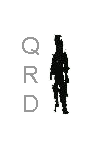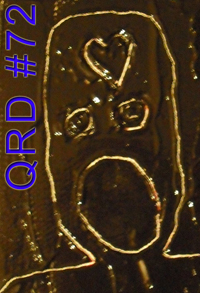
 |
| about
this issue Label Owner Interviews: Silent Media Projects Fruits de Mer Records At War With False Noise J&C Tapes Fourth Dimension Velvet Blue Music Projekt Records Consouling Sounds Felmay Records Lathelight Ltd FilthyBroke Recordings ViVeriVive Public Eyesore Guitarist Interview: Christian Berends Comic Creator Interviews: Casey Brillon Ayal Pinkus Maxime de Radiguès Comic Shop Owner Interviews: Bombshell Comics Jesse James Comics October Country Comics Christian Musician Interview: Baptizer |
 |
 |
 |
 |
 |
 |
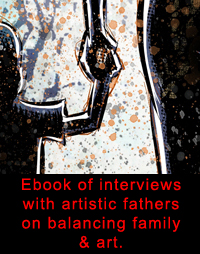 |
|
|
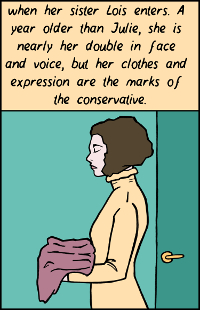 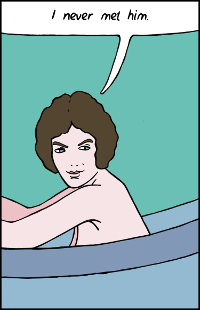 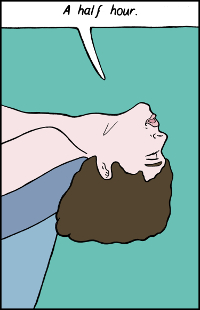 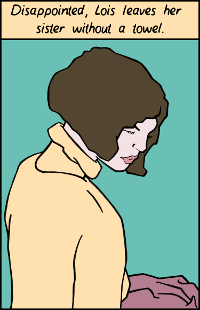 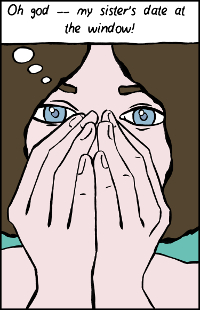 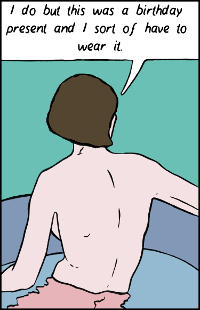 |
April 2015
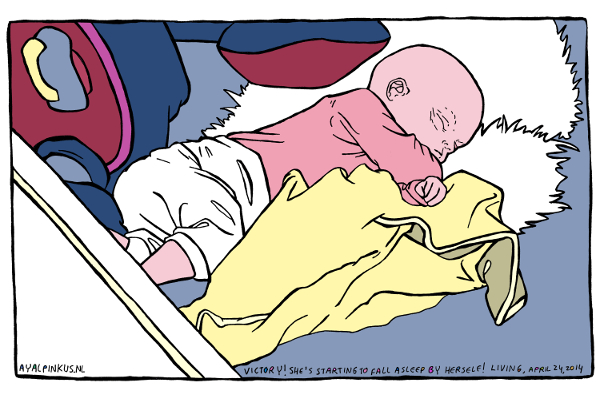
City: Amsterdam, Netherlands
Comics: Several mini-comics, mostly online short story comics
Websites: www.ayalpinkus.nl
QRD – How old were you when you first got into comics & did you always stick with them or did you come back to them?
Ayal – I started making editorial cartoons when I was 38, but in order to do that, I had to make myself angry about something every day & that just wasn’t me. I admired the drawing skills of these cartoonists & I wanted to learn how to do that, but telling longer-form stories felt like a more natural fit for me. So I started doing that & I never stopped.
QRD – What was the first comic book you ever bought?
Ayal – I don’t remember.
QRD – How old were you when you put out your first comic?
Ayal – I put out a few mini-comics in 2010. I was 40.
QRD – What decade do you think produced the best comics?
Ayal – I find that hard to say... There are specific artists whose work I admire for various reasons. They tend to be spread over the decades though. I admire Al Williamson’s, but also Lorenzo Mattotti’s art & storytelling.
QRD – Why comics instead of just writing or drawing?
Ayal – I enjoy both activities & I think a series of images combined with text has the capacity to convey more & with more nuance than one image or only text could.
QRD – Do you see mini-comics & indie comics as paths to mainstream comics or as their own unique media?
Ayal – Mini-comics are their own unique media. Also, I don’t strive to work for the mainstream. I mean, here you have a medium where you can tell any story visually with zero budget. You can experiment; create your own characters, your own worlds, your own stories. Why work for a mainstream publisher? If it’s the paycheck, there are better, easier & equally fun ways to make money.
QRD – How many copies of your comic do you print in your first run?
Ayal – At the moment I print between 250 & 500 comics. Last run was 400 copies.
QRD – How much do you think comics should cost?
Ayal – I find that hard to answer. It depends on the target audience, their budget & the quality of the comic, really. A floppy meant for the tight budgets of children or young parents should obviously cost little, 1-2 dollars. A magnum opus, a timeless masterpiece targeted towards an adult audience, hardcover, printed on archival paper, should obviously cost more, but even then probably no more than 30 dollars.
QRD – How many books do you produce a year & how many would you like to?
Ayal – At the moment I make one per year & I am happy with that. I make short comics during the year & at the end of the year I bundle the best ones into a mini-comic.
QRD – Do you think stories should be serialized or delivered as complete works?
Ayal – I think they should be delivered as complete works. I think you have to have that suspension of disbelief in your audience where they get lost in your story. Ideally, nothing should pull them out of the story, which episodic telling does.
QRD – How are comic strips different than comic books & which medium do you prefer?
Ayal – Comic strips are very short comics that can stand on their own. Next to gag strips you have adventure strips, where the first panel refreshes the reader’s memory about what happened before, & the last panel has a cliffhanger so the reader comes back the next day. They are designed to sell tomorrow’s newspaper. This puts constraints on how much information you can push forward from episode to episode. Their size is usually dictated by size constraints of a medium the creator intends to publish it in, a newspaper for example. Comic books are longer-form & can tell a more nuanced story. I prefer comics & believe a story should get the space it needs to be told.
QRD – How long is it from when you start a comic until it’s printed?
Ayal – I make short comics & bundle them each year, so less than a year. But more than a month as I need to create some distance from it to determine if the short comic is good enough.
QRD – What do you do better with your comics now than when you first started?
Ayal – Both my art & writing have matured a lot. With art, I am continually having to fight rushing it. The more I slow down my art creation process, the better my art & the better my draftsmanship. With writing, I struggle mostly to create characters the audience will care for. I have come a long way in both areas.
QRD – Do you do thumbnails?
Ayal – Yes. I try to do several thumbs for each panel, to try out several designs. I try not to fall in love with my first design because there may be better options.
QRD – At what size do you draw?
Ayal – I draw at 300 percent. I like how my art looks a lot sharper when scaled down. So I work on panels that are intended to be viewed at 2.5 by 3.875 inches. I can blow these up three times & the panel then fits snugly on a sheet of A4.
QRD – What kind of pens do you use?
Ayal – Next to a mechanical pencil for my pencil work, my preferred pens are: Uniball Eye fine, Pentel Sign Pen, & a Platinum Fude brush pen.
QRD – What does your workstation look like?
Ayal – I work on a desk with my computer on it, with reference images on screen & sometimes a podcast coming out of the speakers & I usually have a sheet of paper in front of me to draw on.
QRD – At what point in the artistic process do you work digitally?
Ayal – After I penciled & inked the drawing, I scan it in. I then remove blue lines digitally, enhance the black & white line work through manipulation of tone levels, & then I color digitally. The coloring consists mostly of flatting. I don’t add shade because I want the image to read as easily as possible, to be as light on the eye as possible.
QRD – What do you think of digital comics & webcomics?
Ayal – I love being able to access comics so easily! No waiting for it to arrive by post, no unnecessary trips to a shop, only to find out they don’t carry the comic. Digital is also an amazing opportunity for newcomers to distribute their comics & to build an audience until they have enough fans for a publisher to become interested. I do think that, unlike print, digital is more of an ephemeral thing, here today & gone tomorrow. Web pages come & go, companies come & go. A book is a book. It stands there on your bookshelf. It doesn’t vanish into thin air like many things often do online. I really prefer to have good works in book form so I can revisit them later.
QRD – Do you prefer working in color or black & white?
Ayal – I currently prefer to work in color because it works so well online & printing color pages through a printer isn’t actually that much more expensive than black & white nowadays. But I have done black & white work in the past & I am not opposed to it.
QRD – How many different people should work on a comic & what should their jobs be?
Ayal – I have seen great comics made by one person & I have seen great comics made through collaborations & I think the most important thing is that the result is based on a singular vision as to what the comic is about, its themes, its atmosphere & genre & such. As long as all collaborators understand & work toward the same goal, the result can be good.
QRD – How do you find collaborators?
Ayal – I have tons of stories of my own to work on, but people sometimes approach me for collaborations.
QRD – How tight do you think a script should be as far as telling the artist what to draw?
Ayal – For me personally, I believe screenplays get it right. The script should tell the story, what people say, what they do, & convey the other things like genre & mood so the artist can pick up on that & expand on it. Give the artist room to come up with visual solutions the writer could never have thought of & I believe you get better results. Like with film, it is about interpreting the script, but an artist may know more than the writer does when it comes to framing, staging, lighting, pacing, black spotting, character design, how to guide the eye through the page, abstract composition design, color scheme designs & tonal composition, rhythmic design, line quality, & how to use all of these things to support the telling of the story.
QRD – Do you think it’s important to have a full story arc completely written before starting to draw?
Ayal – Yes, I do. If you change something at the end of the story, that might require you to change other things earlier on in the story. Drawing is a lot of work, so if you need to throw away & redo work, that can be a pain. For me, the whole point of scripting is that you can still easily make changes at that stage. I go through several drafts of the script before I think it is good enough to be thumbnailed. But even during the thumbnailing stage I sometimes find myself changing things. I try to start drawing as late as possible because that is the stage when changes become expensive & painful.
QRD – What comic book person would you be most flattered to be compared to?
Ayal – I think I’d blush if my works, both writing & art, were compared to the works of the likes of Lorenzo Mattotti, Francois Schuiten, Sergio Toppi, Didier Comès, or Andreas. They all create these wonderful literary metaphoric stories in fantastic worlds using highly stylized art based off of realism. I am really truly jealous of that & my work doesn’t come anywhere near their level yet.
QRD – What do your friends & family think of your comics?
Ayal – They say they love them!
QRD – What do you think of superheroes?
Ayal – Superheroes aren’t my thing.
QRD – Marvel or DC?
Ayal – In the Netherlands, both DC & Marvel are all but invisible. There’s one comic shop in the red light district that has a decent collection, but other than that I wouldn’t know where you’d buy them over here. We’ve heard about Spider-Man & Superman of course & there’s the occasional movie that reaches our shores & Americans talk about them online with great reverence, but our comics are very different & we didn’t grow up with Marvel or DC comics. So my answer would be neither. I don’t & didn’t really read their comics & it isn’t really my ambition to work for them either.
QRD – What comic characters other than your own would you like to work with?
Ayal – I am not averse to working with some one else’s characters, but I prefer thinking up my own.
QRD – Ideally would you self-publish?
Ayal – Ideally, I’d like to find a publisher. I don’t like the operations part of it, warehousing, order fulfillment & such. But I am happy to self-publish at the moment.
QRD – What conventions do you try to attend & why?
Ayal – I just attended my first convention, Dutch Comic Con, & it was a wonderful experience! I’m not sure it was my audience really as most visitors were mainly interested in fantasy & science fiction & I lean more towards non-fiction & literary work. But I loved seeing it & there was an amazing, gentle, kind atmosphere. In general, though, I am trying to reach a larger audience that isn’t necessarily into comics.
QRD – How do you feel about doing work for anthologies?
Ayal – I wouldn’t be opposed to it, but I would assume there was no pay (which is fine with me actually), so I would not do work specifically only for that anthology & I would remain owner of the IP I created & I would have final say, artistically, when it came to the story & art. The anthology maker would only get a non-exclusive license, etcetera.
QRD – What do you do to promote your books?
Ayal – Currently, I have a website & a mailing list & I post things on my Facebook account. I plan on sending work to publishers in the coming years.
QRD – Do you think your comics are well suited to comic shops or would sell better elsewhere?
Ayal – I try to create works with literary quality & non-fiction stories & I hope to reach a larger audience with that eventually. That means selling in regular bookstores, museum stores even & such.
QRD – What other medium would you like to see some of your comics made into (television, film, games, action figures, etc.)?
Ayal – Film & television are of course where the big money is & where you get to see big name actors impersonate your characters, along with the Oscars, the red carpet moments & such. So that would definitely be fun, but I am not holding my breath.
QRD – Do you consider yourself a comic collector or a comic reader or both?
Ayal – I see myself as a creator. I do have a collection of comics I admire.
QRD – What do you see as the most viable mediums for comics distribution 10 years from now?
Ayal – Digital, obviously. But print won’t go away. Comics will evolve to be a better fit for online distribution: shorter stories for people who easily get distracted by the rest of the net, better interacting designs for web comics, web comics that aren’t made with print in mind, not as page-oriented.
QRD – What would you like to see more people doing with comics?
Ayal – Read them! There’s so much good work out there already.
QRD – Anything else?
Ayal – Thank you so much for inviting me!
